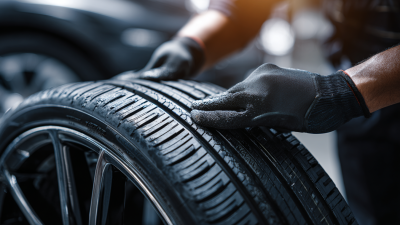The Future of Tire Auto Technologies Shaping Driving Safety and Efficiency
As the automotive industry evolves, tire auto technologies play a pivotal role in enhancing driving safety and efficiency. According to a report by the Tire Industry Association, advancements in tire materials and smart technologies are poised to reduce tire-related accidents by up to 30% over the next decade. Moreover, the global smart tire market is projected to reach $4.2 billion by 2025, significantly driven by the integration of sensors that monitor pressure and tread wear in real-time.

Innovations such as self-healing tires and environmentally friendly materials are not only enhancing vehicle performance but also contributing to sustainability efforts. As we look towards the future, the intersection of tire auto technologies and vehicle automation will redefine safety standards and operational efficiencies on our roads, underscoring the need for continuous research and development in this critical sector.
The Role of Smart Tires in Enhancing Vehicle Safety Features
The evolving landscape of tire technology is set to enhance vehicle safety significantly, particularly through the introduction of smart tires. By integrating advanced sensors and connectivity, these intelligent tires can monitor their condition in real-time, providing vital information on tire pressure, temperature, and tread wear. This not only facilitates proactive maintenance but also enhances overall driving safety by alerting drivers to potential issues before they escalate into serious problems.
As the tire market continues to grow, projected to reach approximately $551.65 billion by 2033, the smart tire segment is poised for remarkable expansion as well. Expected to achieve a market value of over $1.75 billion by 2033, the smart tire industry is witnessing a compound annual growth rate (CAGR) of 6.29%. This growth reflects a shift towards more sophisticated automotive technologies that prioritize safety and efficiency. The increasing reliance on smart tires underscores a broader trend in the automotive industry that aims to leverage technology for improved performance and safety on the roads.
How Advanced Materials Improve Tire Durability and Performance
Advanced materials are at the forefront of revolutionizing tire technology, significantly enhancing both durability and performance. Innovations such as synthetic rubber blends, reinforced polymers, and advanced carbon black composites are being used to create tires that withstand harsher conditions while offering better traction and reduced rolling resistance. This results not only in a longer lifespan for tires but also improved fuel efficiency and driving safety, as these materials can better cope with various terrains and weather conditions.
Tips for maximizing tire performance include regularly checking tire pressure, as properly inflated tires reduce wear and enhance fuel efficiency. Additionally, consider rotating your tires every 5,000 to 8,000 miles to promote even tread wear and prolong tire life. Keeping an eye on the tread depth is essential; using the penny test can help determine if your tires need replacing. By adopting these maintenance practices, drivers can ensure that their advanced tires perform at their best.
Investing in tires made from advanced materials can lead to significant improvements in driving performance. The integration of technology within the tire's design not only enhances grip and control but also adapts to changing road conditions, making driving safer. As manufacturers continue to innovate, the future of tire technology looks promising, paving the way for smarter, more efficient vehicles.
The Impact of AI and Data Analytics on Tire Maintenance and Monitoring
Advancements in artificial intelligence and data analytics are rapidly transforming the tire industry, enhancing driving safety and efficiency. By utilizing real-time data from tire sensors, AI systems can predict tire wear and monitor pressure levels, enabling proactive maintenance that can significantly reduce the risk of tire blowouts. These technologies facilitate a deeper understanding of tire performance under various conditions, providing drivers with insights that were previously unattainable.
**Tips:** Regularly check your tire pressure using automated monitoring systems. These tools not only save time but also help ensure optimal performance and longevity of your tires.
Moreover, data analytics can aggregate and analyze historical performance data, offering predictive insights that inform tire maintenance schedules. This not only extends the lifespan of the tires but also improves fuel efficiency, as properly maintained tires ensure better fuel consumption. As vehicles become more connected, integrating AI-driven analytics with tire monitoring systems will become a standard practice, pushing the envelope of safety in driving.
**Tips:** Consider using apps or services that consolidate tire health data and send alerts for maintenance needs. Staying ahead of tire issues helps maintain vehicle safety and efficiency.
Exploring Sustainable Tire Technologies for a Greener Future
The future of tire technologies is steering towards sustainability, which not only enhances driving safety but also significantly reduces the environmental footprint. Innovations such as tire recycling processes, bio-based materials, and energy-efficient manufacturing techniques are becoming mainstream. For instance, incorporating natural rubber and recycled materials can reduce reliance on fossil fuels, while also improving tire performance and durability.
Tips for choosing sustainable tires: always check for eco-friendly labels that indicate the use of recycled materials or lower emissions in production. Additionally, regularly maintaining your tires can enhance their longevity and efficiency, contributing further to sustainability efforts.
Another exciting development is the rise of intelligent tire technologies. These tires can monitor their own pressure, temperature, and tread wear, communicating with the vehicle's onboard systems to improve safety and efficiency. Embracing such technologies not only ensures a smoother ride but also encourages responsible driving practices, ultimately benefiting both drivers and the planet.
Tips for maintaining tire efficiency: ensure proper inflation and regular rotation to maximize performance. Using tires specifically designed for your driving conditions can also enhance safety and minimize environmental impact.
The Future of Tire Auto Technologies Shaping Driving Safety and Efficiency
This chart illustrates the projected adoption rates of various sustainable tire technologies from 2023 to 2030. The adoption of these technologies is crucial for enhancing driving safety and efficiency while promoting a greener future.
Emerging Innovations in Tire Design for Improved Fuel Efficiency
Emerging innovations in tire design are paving the way for improved fuel efficiency, significantly impacting driving safety and the environment. Modern tire technologies are focusing on materials and tread patterns that reduce rolling resistance, ultimately allowing vehicles to consume less fuel. The adoption of lighter materials, such as advanced polymers and reinforced composites, not only enhances performance but also contributes to lower energy consumption. Additionally, adaptive tread designs are becoming popular, offering optimal grip in various weather conditions without compromising fuel efficiency.
Tips for selecting fuel-efficient tires include looking for those labeled with the "fuel efficiency" rating and ensuring they have the correct air pressure regularly maintained. Keeping tires properly inflated can significantly reduce rolling resistance, leading to better mileage. Additionally, consider tire options that provide a longer lifespan, as longer-lasting tires can decrease the frequency of replacements and the associated environmental impact.
Another aspect to consider is the alignment and rotation of tires, which can enhance their longevity and performance. Regularly checking alignment not only improves safety but also ensures that tires wear evenly, maintaining fuel efficiency over time. By staying informed about innovations in tire technology and implementing these practical tips, drivers can enhance their vehicle's performance while contributing positively to environmental conservation.
Related Posts
-

Exploring the Impact of Tire Technology on Auto Performance and Safety in 2023
-

The Ultimate Guide to DIY Car Tyre Repair Techniques for Every Driver
-

Essential Tips for Dealing with Flat Tires: Your Ultimate Guide to Roadside Assistance
-

The Ultimate Guide to Choosing the Perfect Car Tyres for Every Season
-

Essential Tips for Choosing the Best Tire Repair Shop Near You
-

The Ultimate Guide to Car Tyre Repair Techniques and Their Impact on Road Safety